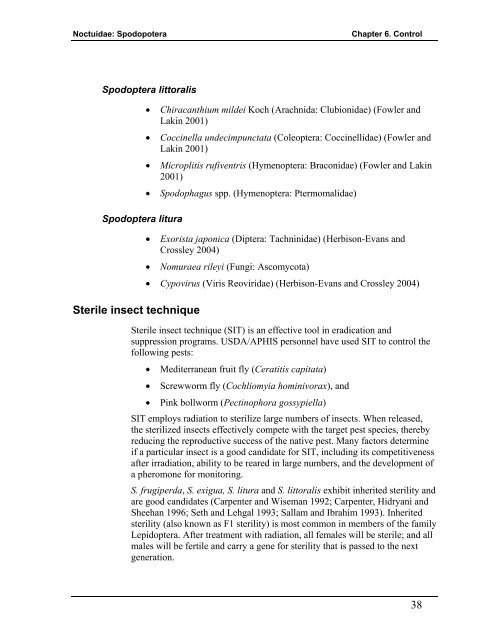New Pest Response Guidelines - Phytosanitary Resources
New Pest Response Guidelines - Phytosanitary Resources
New Pest Response Guidelines - Phytosanitary Resources
You also want an ePaper? Increase the reach of your titles
YUMPU automatically turns print PDFs into web optimized ePapers that Google loves.
Noctuidae: Spodopotera<br />
Chapter 6. Control<br />
Spodoptera littoralis<br />
Spodoptera litura<br />
Sterile insect technique<br />
• Chiracanthium mildei Koch (Arachnida: Clubionidae) (Fowler and<br />
Lakin 2001)<br />
• Coccinella undecimpunctata (Coleoptera: Coccinellidae) (Fowler and<br />
Lakin 2001)<br />
• Microplitis rufiventris (Hymenoptera: Braconidae) (Fowler and Lakin<br />
2001)<br />
• Spodophagus spp. (Hymenoptera: Ptermomalidae)<br />
• Exorista japonica (Diptera: Tachninidae) (Herbison-Evans and<br />
Crossley 2004)<br />
• Nomuraea rileyi (Fungi: Ascomycota)<br />
• Cypovirus (Viris Reoviridae) (Herbison-Evans and Crossley 2004)<br />
Sterile insect technique (SIT) is an effective tool in eradication and<br />
suppression programs. USDA/APHIS personnel have used SIT to control the<br />
following pests:<br />
• Mediterranean fruit fly (Ceratitis capitata)<br />
• Screwworm fly (Cochliomyia hominivorax), and<br />
• Pink bollworm (Pectinophora gossypiella)<br />
SIT employs radiation to sterilize large numbers of insects. When released,<br />
the sterilized insects effectively compete with the target pest species, thereby<br />
reducing the reproductive success of the native pest. Many factors determine<br />
if a particular insect is a good candidate for SIT, including its competitiveness<br />
after irradiation, ability to be reared in large numbers, and the development of<br />
a pheromone for monitoring.<br />
S. frugiperda, S. exigua, S. litura and S. littoralis exhibit inherited sterility and<br />
are good candidates (Carpenter and Wiseman 1992; Carpenter, Hidryani and<br />
Sheehan 1996; Seth and Lehgal 1993; Sallam and Ibrahim 1993). Inherited<br />
sterility (also known as F1 sterility) is most common in members of the family<br />
Lepidoptera. After treatment with radiation, all females will be sterile; and all<br />
males will be fertile and carry a gene for sterility that is passed to the next<br />
generation.<br />
38













